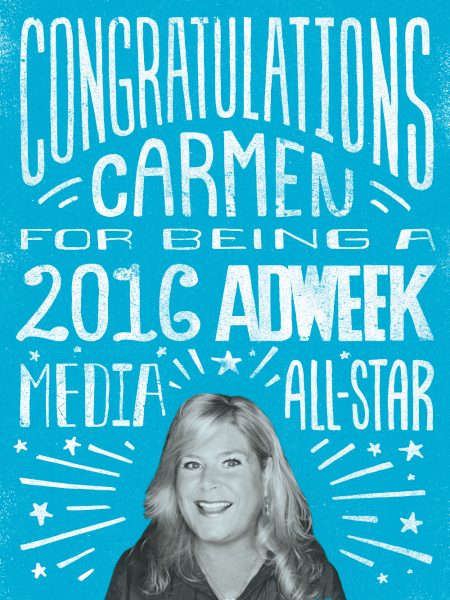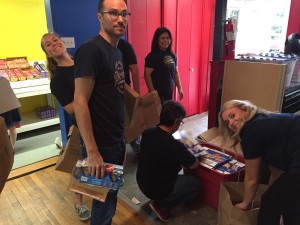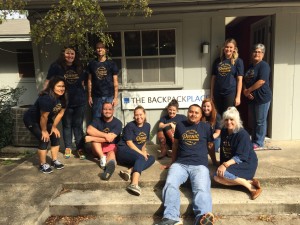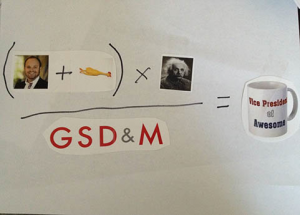Every year for the past 30 years, Adweek’s Media All-Star award has honored the most trailblazing media executives in the business. And this year, with little surprise to us, Carmen Graf was named an Adweek Media All-Star. Ask anyone who has worked with Carmen Graf, executive director of GSD&M’s media department, and they’ll tell you why she’s one of the 12 executives in the country to be honored this year.
Adweek saw no oversight into her many achievements such as being named a Media Star of the Future by Newsweek, earning a Silver Effie Award, being named a media finalist at Cannes and being part of the BMW/Graffiti campaign, which Forbes named one of the best social media campaigns of all time.
With her intuitive and creative approach, Carmen exemplifies the quality of charisma required for her capacity of work, and in her 24 years at GSD&M, she has channeled that energy, creativity and forward-thinking to make serious moves for the media department. You’re an all-star, Carmen! Congrats. Learn more about the honor right here.

Artwork by GSD&M designer, Laura Guardalabene
Aerie, American Eagle’s undies brand, has done away with advertising retouched models and is keeping it au naturel, and we (and its sales numbers) are in favor. As a group of strong-minded, creative female consumers in the advertising industry, we had some opinions about this business decision and its recent news, naturally.
Heather Apple, senior writer. Bold as she is blonde.
“Brands can support women for good and for profit. That’s what Aerie’s success proves: These aren’t mutually exclusive. It’s common sense. We spend so much time trying to understand our target; we should represent them—all of them.
“We still have a lot of strides to make to represent women of different sizes, ages and ethnicities, so if we could stop overlooking (and Photoshopping) those women, that’d be a big deal. If one brand shows real women, other brands will follow. Then eventually, we’ll see powerful, smart women of all shapes and sizes portrayed in the media.”
Alicia Ross, project manager. Only thing realer than her is her curls.
“I have two teenage sisters, 18 and 16. And even though we’re close, with social media, I have so much access into their personal thoughts because it’s 2016, and if they don’t tweet about it, then it didn’t happen.
“A recent tweet from my 18-year-old sister: ‘Buy all this makeup and I’m still ugly.’
“What? Nooooo.
“And from my 16-year-old sister: ‘This last year of body positivity toward myself (and everyone else) has really paid off. I love myself; ain’t no shame in my game. But as with anything, I still have progress to make.’
“That makes me super happy, but damn, why do 16-year-olds have to spend a year focusing on body positivity?
“So, if they’re shopping at a place where they can walk in and see attainable, realistic beauty where there are pictures of girls with folds in their stomach while sitting at the beach—because THAT’S WHAT BODIES ACTUALLY DO WHEN YOU SIT ON THE BEACH—then I feel really awesome about that. That’s where I want them to shop. That’s where I want to shop for them.”
Summer Ortiz, studio artist. You should see the girl sketch.
“Having had my own body issues through my adolescence and into adulthood, I’ll admit that I’ve been the person to give a perplexed sneer at this movement toward ‘real’ women in advertising.
“I’ve thought to myself: ‘Why is she in an ad? If a woman who looks like that can be in something like this, anyone could. I could.’
“But isn’t that the point? I was conditioned to think I should feel inferior to the women in ads. But why? Real women are beautiful.
“And from a sales perspective, this tactic is smart. If I see a woman with a body that more closely resembles mine, wearing something I too think I can look good in, I feel more confident purchasing it. I can’t tell you how many times I’ve seen something on a model and purchased it, only to try it on and be reminded that I am not 6’1″ and a size 00. And then, not only do I feel badly about myself, but I feel negatively toward that brand, and I am less likely to buy from it again.
“This kind of advertising could change that cycle.”
Leslie Shaffer, creative director. She woke up like this.
“I love that this was a pure business move. Aerie didn’t stop retouching because of its own principles. It did it because it knew young women would be into it and spend their money with Aerie. That says a lot for a generation that gets a bad rap most of the time.
“Let’s stop advertising to some sad, imagined lowest common denominator and start assuming people are as smart and confident as they really are.”
Our experiences are different, but among us women, there’s a common trend: We’re all craving some realness and some rawness—some curves on the beach and some butts at the pool—because it’s time for brands to start reflecting its audience, not the other way around. Talk about an idea that makes a difference.
Reverend Roy. He’s known for co-founding GSD&M in 1971 with partners Judy Trabulsi, Steve Gurasich and Tim McClure, but he’s perhaps best known for his electric and passionate personality. So, it was with joy and pride, yet little surprise, when we learned our fearless leader would be the first Austinite and second Texan to be inducted into the American Advertising Federation’s 67th Annual Advertising Hall of Fame. His accomplishments include bringing on renowned brands like Southwest Airlines, Walmart, AT&T and Charles Schwab to the GSD&M roster, authoring three books, co-founding The Purpose Institute to help companies find their core purpose and values, and even starting his own hot sauce line, Royito’s. But it is Roy’s heart, as President Bill Clinton noted at the induction ceremony, that’s led him to success in advertising, leadership and all aspects of life. We couldn’t be more proud of you, Reverend Roy. Ride At Dawn!
I ran to the grocery store after work last night to pick up items for a volunteer opportunity today—the Backpack Coalition. It’s only fair to admit that the grocery run came after a lengthy internal conversation about how I was “too tired” from a long day at work to go pick up groceries. Luckily, my conscience took over that conversation and I was quickly reminded of my purpose: not live for myself, but rather for others.
As some background, the Backpack Coalition is an organization that provides food to underprivileged children in Austin. There are a lot of kids who eat only when they’re at school—breakfast and lunch—and won’t eat until they return to school the next day. So, when they leave school on Friday, they will have little to no access to food until they return to school the following Monday. This hugely hinders their ability to learn as it takes the brain two to three days to recover full cognitive ability—meaning they won’t begin learning again until Wednesday.
I imagine these kids sitting in a classroom surrounded by students who are dressed in new back-to-school clothes, barely worn sneakers, with a backpack full of school supplies and homemade snacks to last them the day—and much further than that. Meanwhile, these students are hungry—hungry—and the thought of learning is near impossible when they’re distracted by the sound of their own stomachs growling.
I kept this thought in mind when I was at the grocery store last night, hesitating on how many groceries to buy for the kids. And when my cart was maxed out and food was dropping in the aisles, I still felt like it wasn’t enough. And it wasn’t because at the end of the day, I’d still go home, open a full fridge of food, and prepare a warm—and let’s be honest, underappreciated—home-cooked meal.
Today, a group of us volunteered at the Backpack Coalition; we packed backpacks full of food for these kids to have this weekend and over the holidays when they’re out of school for a week and looking for something to fill their stomachs. As if that experience wasn’t “real” enough for us, we heard stories about the children we were impacting. One in particular was about a mother who received a grant to go to college, which would ultimately ensure that she could provide a better life for her children. But, that grant meant that she was no longer eligible for food stamps. So, she had a decision to make: short-term or long-term wellness for her family. But because of the Backpack Coalition, she didn’t have to choose; she was able to go to college, set an example for her children, and ensure her kids were fed. In reality, though, it really doesn’t matter how much money we spent on groceries to donate or how much time we spent packing backpacks. What matters is that we took a few hours out of our day to give back to others—to people with stories like that mother—and do our part to make the world a little better of a place than it was last night when we went to bed and this morning when we rose.
In reality, though, it really doesn’t matter how much money we spent on groceries to donate or how much time we spent packing backpacks. What matters is that we took a few hours out of our day to give back to others—to people with stories like that mother—and do our part to make the world a little better of a place than it was last night when we went to bed and this morning when we rose. But this opportunity to better ourselves and our planet wasn’t a solo effort. At GSD&M we are encouraged to volunteer. Now, there are a lot of companies out there that say that. We’ve all heard it—“we encourage our employees to do their part.” But GSD&M doesn’t just talk, it walks. Each month, we are given four hours to volunteer and not only are we given this time away from our desks, but we’re paid for it too. And further than that, the employees work together to make each other aware of how they are volunteering, and even go as far to share it in the internal news so it’s easy for anyone to jump on the train and volunteer. Just this week we had a box set up in the lobby so people who didn’t volunteer for the Coalition could still donate food.
But this opportunity to better ourselves and our planet wasn’t a solo effort. At GSD&M we are encouraged to volunteer. Now, there are a lot of companies out there that say that. We’ve all heard it—“we encourage our employees to do their part.” But GSD&M doesn’t just talk, it walks. Each month, we are given four hours to volunteer and not only are we given this time away from our desks, but we’re paid for it too. And further than that, the employees work together to make each other aware of how they are volunteering, and even go as far to share it in the internal news so it’s easy for anyone to jump on the train and volunteer. Just this week we had a box set up in the lobby so people who didn’t volunteer for the Coalition could still donate food.
While I’ve just written many, there are few words to explain what it feels like to be part of a company that has a strong sense of purpose and community and continues to evolve to ensure that this purpose and “sense of self” is never lost.
Today’s opportunity to give back to the community felt less like a gift I was giving and more like one that was given to me. And I am 100 percent confident that this gift wouldn’t exist if my company wasn’t pushing me forward, and strongly encouraging me to take four hours out of my day and put it to good use.
It’s one thing to develop our own sense of purpose. It’s not easy, but we spend our lives attempting to do and fulfill it. But how often do we get to say we stand with a company that has it’s own sense of purpose, and a damn good sense of purpose at that?![image1[1] copy](https://stage.gsdm.com/wp-content/uploads/2015/11/image11-copy-300x225.jpg)
The lazy, too-busy-for-this part of me wants to chalk up our entry in this year’s Spicewood Demolition Derby to the fact that crashing cars sounds fun, and we like to do fun things, so we entered.
Alas, it isn’t that simple. It never is.
Truthfully, the idea started with GSD&M Associate Creative Director Joel Williams, who attended last year’s derby and saw an opportunity to bring the agency to a side of Texas it rarely treads upon. (The story is a good one: He tricked his son into believing they were on the way to check out tile samples. Forty-five minutes and a dirt parking lot later, his son realized there were no tiles to sample. He was not disappointed.) So, with the help of our willing and able design team, we started taking steps to make this dream of entering the derby a reality. We even thought of getting a project manager.
While Design Director Marc Ferrino and the gang designed their hearts out to create GSD&Molition swag including shop rags, koozies and t-shirts (shameless plug to buy their stuff!), Joel and I scoured Craigslist in search of our soon-to-be death machine. It wasn’t easy—the car had to be cheap enough to crash and fit enough to run—but in the end, we found her: a 1996 Ford Thunderbird.![IMG_2435[3] copy](https://stage.gsdm.com/wp-content/uploads/2015/09/IMG_24353-copy-300x231.jpg) Pictured: Joel Williams
Pictured: Joel Williams
Then came pre-production. Joel went to town removing all unnecessary parts from the car to make her light and nimble and fit for a Mad Max film. Marc put in a preliminary order on merchandise that sold out almost instantly. I wrote this blog post. Teamwork, as they say, makes the dream work.![gsdemolition[8] copy 2](https://stage.gsdm.com/wp-content/uploads/2015/09/gsdemolition8-copy-2-300x300.jpg) What’s been so fun and so rewarding about this whole process has been the unbridled creativity. As ad creatives, we work inside sandboxes for a living, passing ideas through business-conscious filters that sometimes hold the best stuff back. It’s the nature of the beast, and we love to do it. But every now and then, an opportunity to run headfirst into a project without supervision or even proper safety equipment feels good. I would even say it’s necessary. And I thank everyone who has helped make this possible.
What’s been so fun and so rewarding about this whole process has been the unbridled creativity. As ad creatives, we work inside sandboxes for a living, passing ideas through business-conscious filters that sometimes hold the best stuff back. It’s the nature of the beast, and we love to do it. But every now and then, an opportunity to run headfirst into a project without supervision or even proper safety equipment feels good. I would even say it’s necessary. And I thank everyone who has helped make this possible.
On Saturday, we’re going to see what we, and the car, are made of. The crash goes down at 6pm at the Spicewood Fire Department, and as it’s our ongoing priority to continue to give back to our community, all proceeds from our merchandise sales will benefit our friends at the Spicewood Fire Department (who will likely be saving us from the wreckage that once was our Ford Thunderbird). We may not win but, honey, we’re going to look good trying, and we’re going to be damn happy either way.
Hope to see you there.
Editor’s Note: As part of our new blog feature “Get to Know..,” we will give our readers a look inside GSD&M as we interview various employees about their role and bizarre-o talents and hobbies.
For this edition, you’ll hear from Jonathan Hart, VP/Decision Sciences:
So what exactly does decision sciences mean?
Decision Sciences is a collaborative approach involving mathematical models, business tactics, technological applications and behavioral sciences to make data-driven decisions. There will be a quiz later.
Give us a look inside your typical day.
Occasionally I drink half a bottle of scotch at lunch and then spend the afternoon calling people into my corner office so I can criticize their poor typeface choices and unprofessional dress (We are trying to run FORTUNE 500 companies here, not lemonade stands!). (Editor’s note: He’s kidding.)
World of Warcraft username?
I’ve never played WoW, but I have been a Final Fantasy fan since I was very young. I recently became the 15th person in the world to collect every achievement in their MMORPG…after playing it for over 10 years. This is probably the most awesomely embarrassing thing I could admit about myself.
You led a GSD&M Ideas That Make A Difference presentation that hinted you believe we may all simply be participants in a video game simulation, which is pretty crazy to think about, tell us more.
This is actually a very old idea. Plato, Descartes, the Dalai Lama and other philosophers have speculated on it for centuries, but only recently have we begun to understand how technology might actually make this possible to construct or detect. To anyone paying attention, it’s quite obvious that there is more going on in our world than can be directly observed. Spectrums of light we can’t see, sounds we can’t hear and phenomena we can’t explain. If you have spent time in nature, had a religious experience, experimented with drugs or really made an effort to contemplate on our size in the cosmic scale, you know this to be true. When did you know you wanted to focus on analytics?
When did you know you wanted to focus on analytics?
I was initially drawn to the field of economics as an undergraduate for its use of analytical tools to solve problems that are otherwise of an overwhelming scale and complexity. I was fascinated by how these techniques could transcend scientific theory and be directly applied to solve industrial challenges. I find the leverage that computational power gives us captivating—the ability to scour inconceivable volumes of data to generate counterintuitive insights that have been overlooked by even the most skilled practitioners.
Big data is all the rage, but how can brands better use small data?
It’s very hard to change the way we make decisions. Much of our personal value and self-worth is tied to having expert knowledge. More often than not, data of any size is used to help prove something we already believe, not to learn whether or not that belief is valid. I was floored the first time I heard the term “evidence-based medicine.” What have we been basing our medical decisions on up until now?
What do you do for fun?
I collect books. I own almost every book I’ve ever read in hardcover. #destroykindle
The UT Longhorns and Georgia Bulldogs are going head-to-head in the National Championship, who do you cheer for?
Is this a question? SEC, SEC, SEC.
You’ve lived in international cities like London and New Delhi, how does that compare to your experience working in Austin?
We seem so different, but we are really not; people are mostly the same everywhere. They care and worry about the same things. Finding a sense of self-worth, trying to understand “why,” belonging to a community, providing for their family and improving the opportunities available to their children.
Proudest moment at GSD&M thus far?
It has to be the Decision Sciences team winning the annual Christmas Card Contest. It was awesome to see them so fearlessly embrace their nerdiness and bring such passion to showing others what they are capable of.
What characteristics do you look for people when hiring talent?
I like people who come at problems sidewise. Something like 80% of innovation supposedly comes from cross-pollination between industries. I almost never hire anyone with an advertising background. You can teach people an industry, but it’s much harder to teach them to think. I find the people who tend to be most successful are the people who could do two or more jobs, because it helps them to think holistically and attack a problem from multiple angles.
Sum up GSD&M’s culture in one word? heteroscedastic